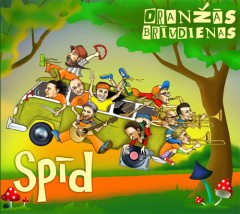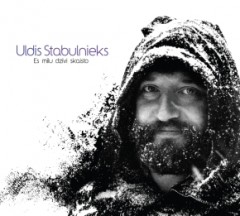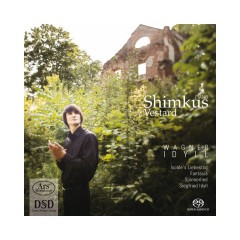
Spīd, the latest album from Latvian ensemble Oranžās brīvdienas is one of the most fun and creative Latvian albums to be released for quite some time
According to their website, Oranžās brīvdienas describe themselves as ‘TurboFolk’, which features elements of “ska, reggae, metal, rock, disco and other styles mixed with some folk elements”. And this is not at all an exaggeration – the album does truly feature all of these styles, though the ska element seems the most prominent of all of them.
The group has been around for a while – it was founded in 2000 by Ints Ķergalvis – guitarist, vocalist and music and lyric author for all the songs. On Spīd, Ķergalvis is joined by an army of musicians, including Māris Vaivods on bass, Kaspars Čakste on mandolin, Andžs Zvirbulis on electric guitar, drummer Jānis Puzaks, Ritvars Šilkovs playing the saxophone, two trombonists (Maksims Starodubovs and Jānis Kaličus), trumpeter Nauris Bruņinieks, as well as Pēteris Birzgalis performing sound effects.
Oddly enough, the band’s sound and style might periodically remind one of satirical Latvian group Labvēlīgais tips – both groups have horn sections, and both groups sing songs with lyrics that are at times comic, at times rather strange. For example, the title track ‘Spīd’, has a double meaning – ‘Spīd’ in Latvian means ‘shine’, but it pronounced the same way as the English word ‘speed’ – which is quite appropriate, given the song’s uptempo nature and driving drumbeat.
“Pēdējais metālists” (The Last Metalhead) takes a turn towards the heavier, with the song beginning with a metal riff that would not have been out of place on a 1980s thrash record. The horn section even joins in, making for a particularly unusual combination of sounds. It even features some growled death metal vocals at the end. Unfortunately, no lyrics to be found in the booklet or on their website, so it’s up to the listener to guess what he’s growling there!
Many of the songs are captivatingly odd, like the aggressive ‘Sašauti Merši’, where Ķergalvis sings about how his dream cars are shot up Mercedes. Or, perhaps, the somewhat tongue-in-cheek ‘dance’ song ‘Jauno latviešu diskotēka’
Packaging is pretty sparse though, no booklet or lyric sheet, though you can find more information about the group at their website. In fact, you can even download their first album, 2011’s Evribadi tancevaķ, in full. Lyrics would have been nice to have, as they’re not easy to figure out, and would help one appreciate the album more.
Spīd is truly an eclectic journey through varying musical styles, with one surprise after another and always engaging and enjoyable. Particularly impressive is how Oranžas brīvdienas integrates all the many musicians into a very cohesive ensemble – the horn section in particular is what makes this album particularly memorable. Deftly moving between varying styles, often in the same song, Spīd, is one of the most creative recent Latvian releases.
Artist website: http://www.oranzas.lv
Details
Spīd
Oranžās brīvdienas
Latvia: Naba Music/Melo Records, 2012
Track listing:
1. Spīd
2. Pavasaris
3. Rokstārs un gripa
4. Sašauti merši
5. Svītru koda ielas variants
6. Pēdējais metālists
7. Sociālā taisnīguma vārdā
8. Jauno latviešu diskotēka
9. Saraudātais kabatsdrāns
10. Slīkoņa rokenrols
11. Tur tava vieta
12. Spīd (garais)





